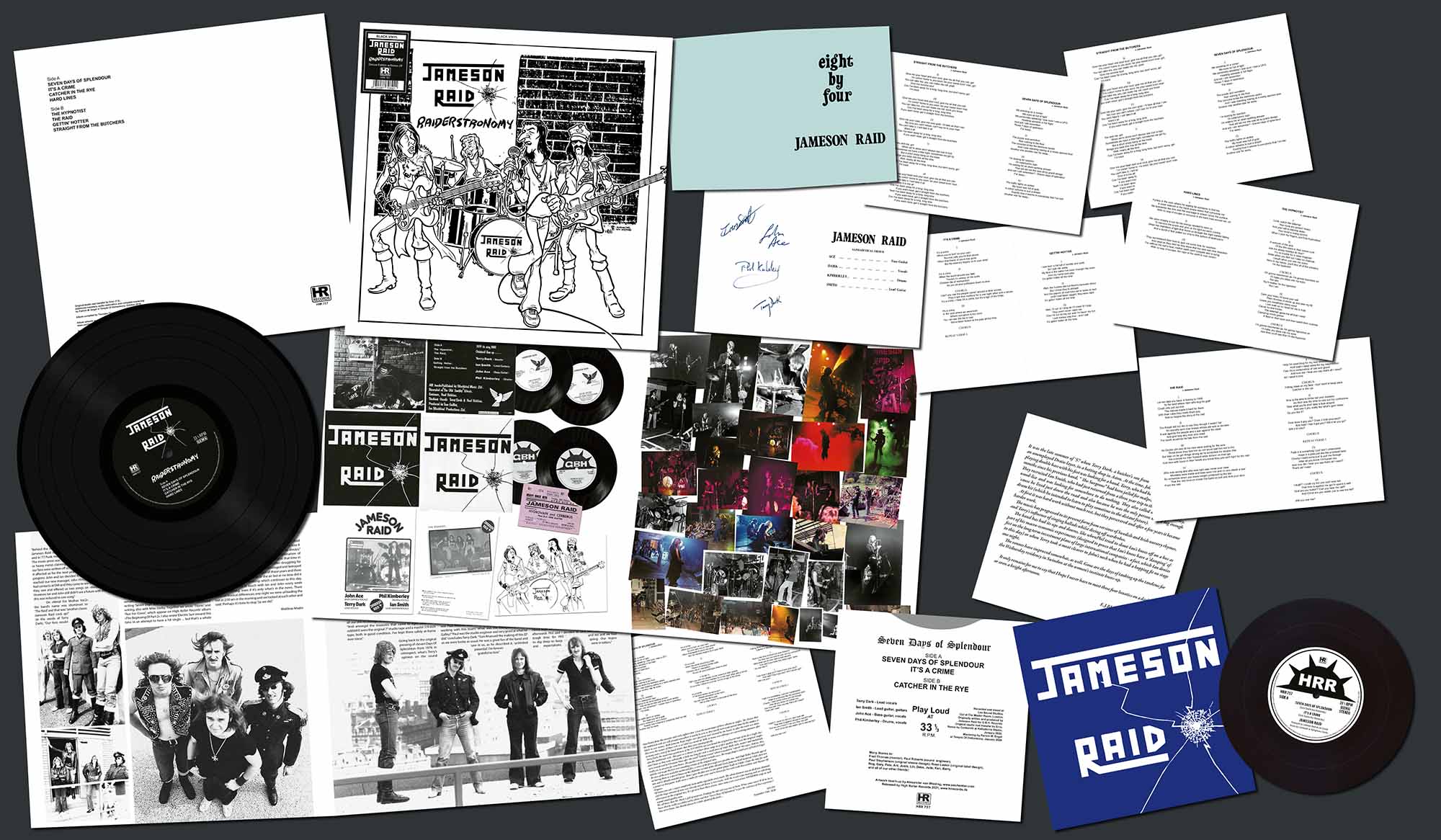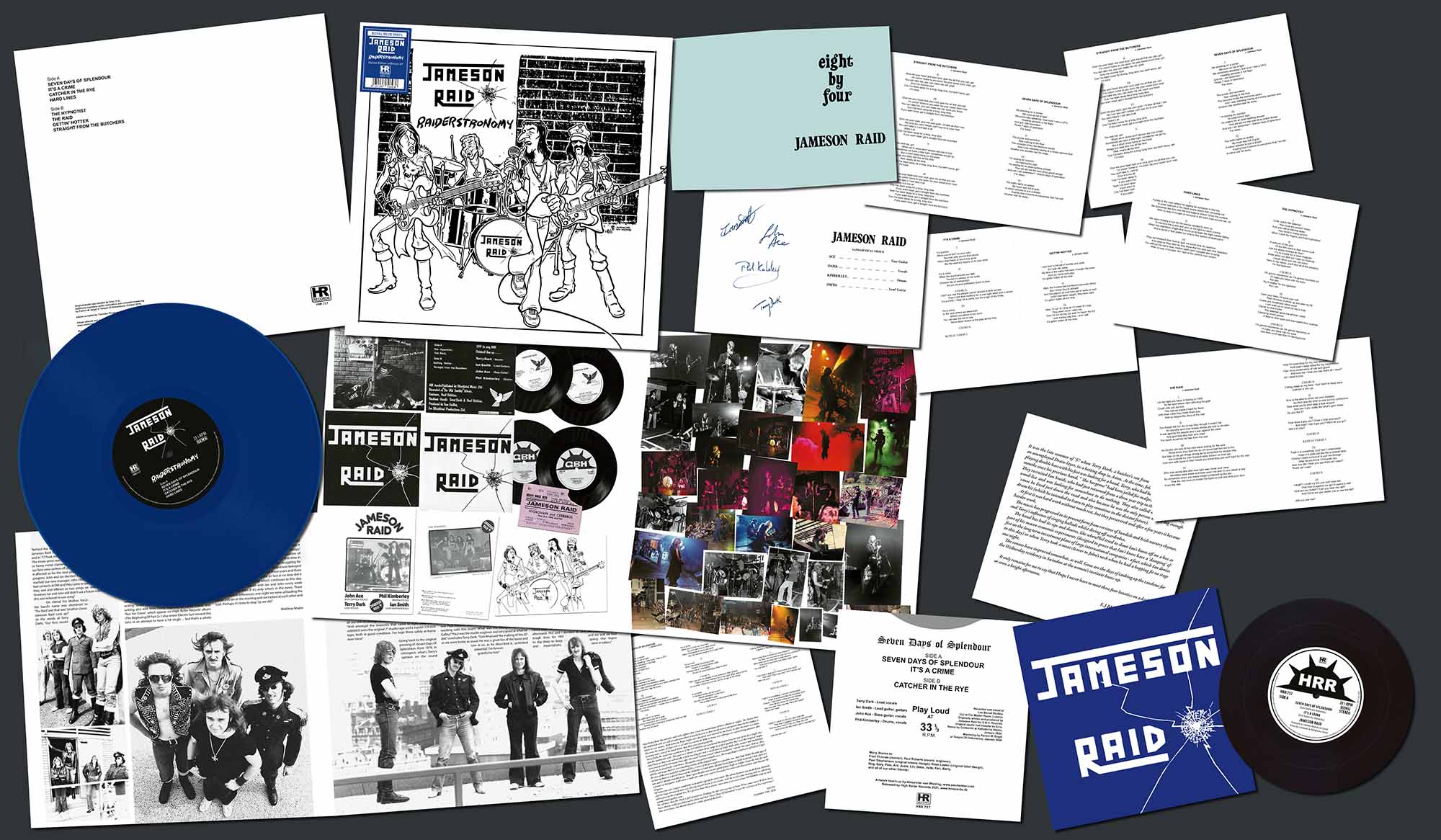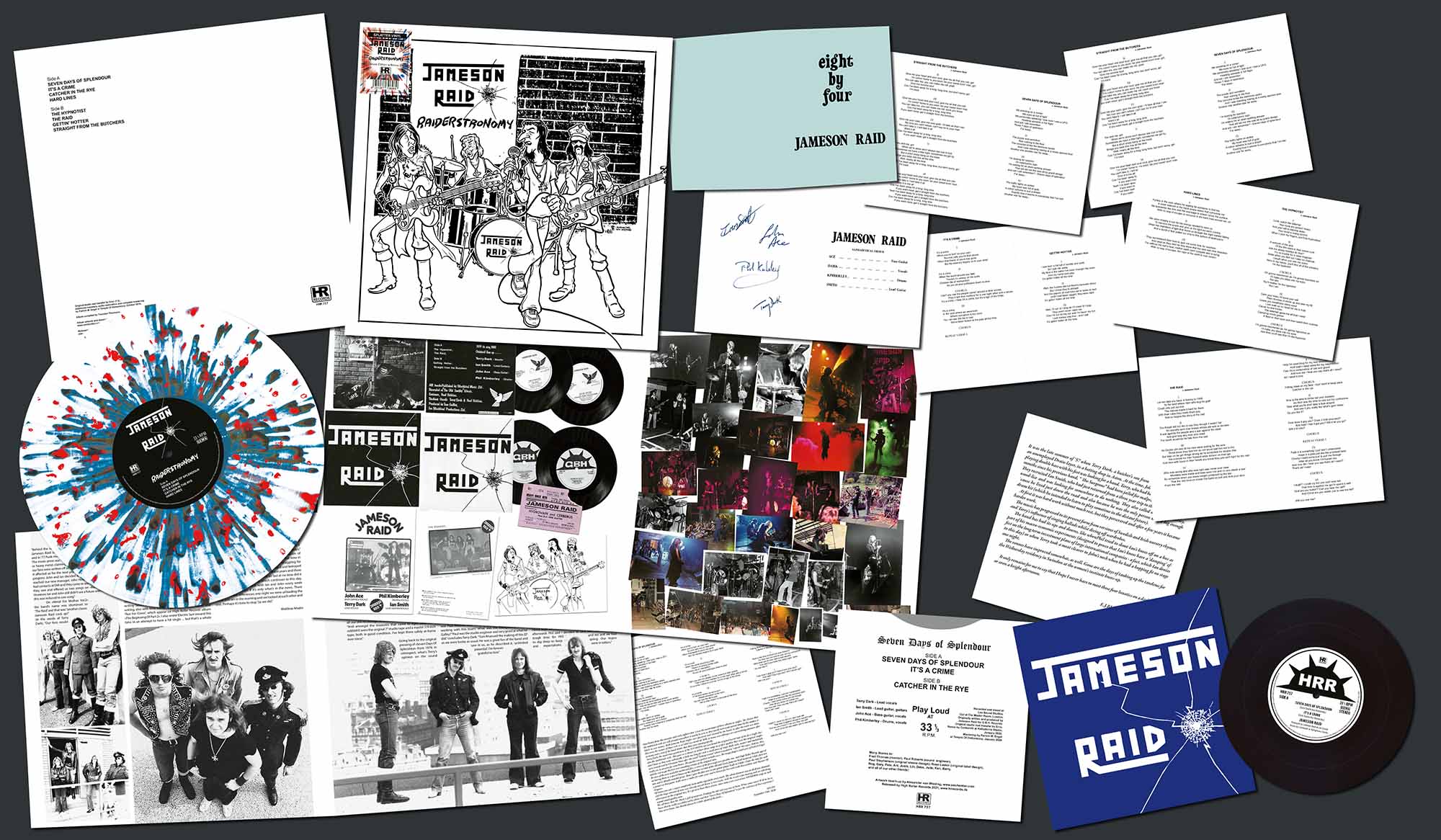 | ||||
| JAMESON RAID - Raiderstronomy LP+7" | |
HRR 757LP, ltd 500, 200 x black vinyl + 200 x transparent royal blue vinyl. 100 x white/ red/ blue splatter vinyl, 425gsm heavy cardboard cover with 5mm spine, 4 pages insert, 16pages songbook, black vinyl bonus 7” with p/s | |
| Terry Dark - Vocals (lead & backing) Ian Smith - Guitars John Ace - Bass Phil Kimberley - Drums | |
| 01 Seven Days of Splendour 02 It's a Crime 03 Catcher in the Rye 04 Hard Lines 05 The Hypnotist 06 The Raid 07 Gettin' Hotter 08 Straight from the Butchers 09 Seven Days of Splendour (Remix) 10 It's a Crime (Remix) 11 Catcher in the Rye (Remix) | |
AVAILABLE | |
Original studio reel transfer (tracks 1-3) by Eroc.
Remix of the 1st single by Coldsmith at KALLIPHONIA STUDIO, January 2020.
Vinyl transfer, audio restoration and complete mastering by Patrick W. Engel at TEMPLE OF DISHARMONY, October 2019 / January 2020.
Cutting by SST Germany on Neumann machines for optimal quality on all levels... The ultimate audiophile edition of this eternal NWOBHM classics. THE ULTIMATE RAID!
The current re-issue of NWOBHM legends Jameson Raid on High Roller Records features the band’s first two 7” singles plus “Hard Lines” from the prestigious »Metal For Muthas Vol.2« compilation. The sound is far superior to the original High Roller release. Everything has been mastered from the original source. Jameson Raid singer Terry Dark is more than happy with this ultimate edition of his band’s classic material: “I'm really stoked to have our record company, High Roller Records, taking charge of this project. Their professionalism is well known, always a high quality result and I think bands deserve this attention to detail. The re-mastering of these tracks, with the resulting dramatic improvement in quality, clarity and definition has delighted me personally and reflects what modern technology can do. However, behind the dials and switches there is always a man and the guy who did this deserves a big, gold medal.”
The icing on the cake will be a bonus single featuring a 2020 remix of the original »Seven Days of Splendour« 7” EP. So this means someone must have found the original master reels of »Seven Days Of Splendour«, when and where were they found? “When Jameson Raid did the 2010 reunion gigs in the UK and at Germany's Headbanger’s Open Air, we collected all our old recordings to help us practice,” explains Terry Dark. “And amongst the treasures that came to light (and some rubbish!) were the original 7" studio tape and a master 1/4 inch tape, both in good condition. I've kept them safely at home ever since.”
Going back to the original pressing of »Seven Days Of Splendour« from 1979. In retrospect, what’s Terry’s opinion on the sound and the production of the three songs? “Many people consider »Seven Days Of Splendour« to be a classic heavy metal song,” he states. “And they say, you should never mess with a song like that! I believe that the EP gave a very good idea of what Jameson Raid was about at the time, melody, energy, our own sound and original songs. Had we had thousands to spend then maybe the sound could have been better, especially with the drums … but maybe not so, although the re-mix is great, I'll never complain about the original.”
The original 7” was recorded and mixed at Lee Sound Studios, which according to Terry Dark “was a small but efficient local studio in the West Midlands near to our Birmingham base.” He continues: “We had help from one or two people with the production, as well as our own input. Unfortunately, it was so long ago and I have gaps in my memory... so I can't recall their names. The GBH label, which we said was ‘Great Birmingham Heavy’, was our own invention.
»Seven Days Of Splendour« was cut at The Master Room in London, back then that was quite a prestigious place. “There was nothing comparable in our area, so we decided to have it done at the best we could afford,” adds Terry Dark. “No regrets there either.”
Jameson Raid’s second single »The Hypnotist« was recorded at the Old Smithy in Worcestershire. The engineer was Paul Robbins and the producer Tom Galley. How was it working with this team? What was the background of Tom Galley? “Paul was the studio engineer and very good at what he did,” concludes Terry Dark. “Tom financed the making of this EP as we were broke as usual. He was a great fan of the band and saw in us, as he described it, ‘unlimited potential’. I'm forever grateful to him.”
On the cover of »The Hypnotist« the newspaper poster in the background said: “Jameson Raid story: End of part one”. Was this a slight hint at the fact that the band in its original from was about to split up soon after the single, that an era was coming to an end? “To tell the truth,” explains the singer, “the second EP has, for us, the title »End of Part One«. “But because of the design, many consider it to be called »The Hypnotist«. A typical Jameson Raid fuck up! We knew that Ian (Smith, guitar) and John (Ace, bass) were leaving the band but persuaded them to make this record featuring some of our most popular songs at the time. Phil (Kimberley, drums) and I had already decided to find new players and continue, so for us it was truly the end of part one with part two to follow.”
The song “Hard Lines” appeared on »Metal For Muthas Vol.2« in 1980. Was that a brand new song? Was it specifically written for »Metal For Muthas Vol.2«? “We wrote ‘Hard Lines’ also in 1979 and the song went through a few changes,” elaborates Terry Dark. “We made the first recording of the song at a BBC studio in the UK and produced it ourselves. The BBC soundman was shocked and kept asking why it had to be so damn heavy …? Well, how do you explain that to someone? »Metal For Muthas Vol.2«. We knew all about »Metal For Muthas Vol.1« and it was very obviously a sign that things could change. After all, EMI's a huge record company and after they came to see us, they also said they wanted to sign the band. However, with two guys leaving, EMI's offer was withdrawn. Unfortunately, John Hinch kept this and other information to himself, so shortly afterwards Phil and I decided to sack him. This was a very tough time for Phil and me and we had to dig deep to keep going. Our hopes and expectations were in tatters.”
“Behind the scenes in most bands there are problems,” the Jameson Raid singer continues. “I joined the band in 1976 and in '77 Punk music exploded on the music scene in the UK. The music press was extremely against any form of hard rock or heavy metal, claiming it was worse than rubbish and even our fans were written off as dumb people. It was a disgrace but it affected us for the next years making it very hard to make progress. John and Ian decided to give up the fight and word reached our new manager, John Hinch (ex-Judas Priest.) John had contacts at EMI and they came to see the band, loved what they saw and offered us two songs on »Metal For Muthas«. However, Ian and John still didn't see a future with the band, so this was reduced to one song.”
On »Metal For Muthas Vol.2« the band’s name was shortened to ‘The Raid’ and that was “another classic Jameson Raid cock up!” (in the words of Terry Dark). “Our fans would write to us and say, for example: ‘When are the Raid playing again?’. Or simply: ‘I'm a big fan of the Raid’. And so we decided to drop the ‘Jameson’ part of the name and continue on as The Raid. Wrong! This caused so many questions and so much confusion we had to reverse the decision but in the meantime »Metal For Muthas Vol.2« had been released. The change of name back to the full Jameson Raid coincided with the EMI album coming out.”
In 1980, Jameson Raid continued with a new line-up, as Terry Dark explains: “It may be very surprising but many fans saw us for the first time after Ian and John quit the band. We'd quickly found new and good musicians in Mike Darby and Pete Green and we carried on gigging as before, often doing more gigs a week and after a short time we were playing the same bigger venues as before. People also knew that I was responsible for writing ‘Seven Days’ and ‘Catcher In The Rye’ and I continued writing, also with Mike Darby. Together we wrote ‘Titanic’ and ‘Run For Cover’, which appear on High Roller Records’ album »The Beginning Of Part 2«. I also wrote ‘Electric Sun’ around this time in an attempt to have a hit single ... but that's a whole other story which you would probably not believe, even if I told it. Yes, we had offers which we turned down.”
When and why exactly did the original Jameson Raid split up? Was it the frustration of not getting singed or was it rather musical differences or personal problems? “As always,” Terry Dark finishes off the story, “it was a combination of factors that led to the demise of Jameson Raid at that time in 1982.” “Phil and I were undoubtedly tired after struggling for years and being hampered, criticized, sabotaged and betrayed by different people at different stages of those years and there certainly was a lot of frustration in the air but at no time did it affect Phil and mine's friendship which continues to this day. And we're both still in touch with Ian and John every week about something, even if it's only what's in the news. There were no musical differences; one night we were unloading the van at 2:00 am in the morning and we looked at each other and said: ‘Perhaps it's time to stop.’ So we did.”
Matthias Mader



